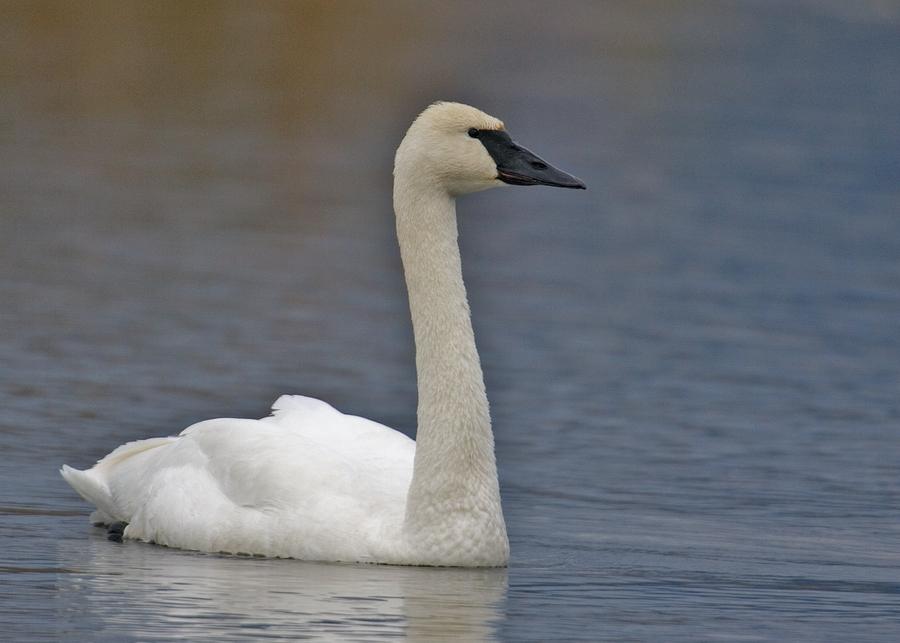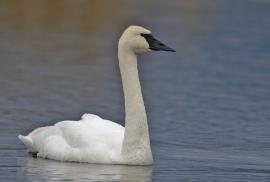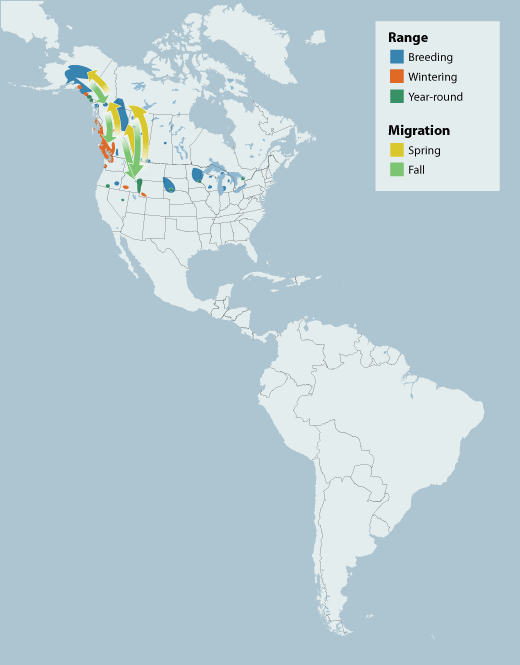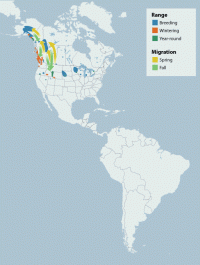Guide to Boreal Birds
This is an in-depth boreal species profile.
What is this?
This species is one of more than 30 birds selected for in-depth profiles. Find out why and see all selected boreal birds »
Overview
Few birds are loved and admired more than swans. They are considered symbols of grace, beauty, serenity, and fidelity. Yet the Trumpeter Swan, North America's largest native waterfowl species, became a symbol of the consequences of greed and vanity as it was hunted relentlessly for its skin and feathers from the 1600s to the 1800s. Draining of marshes, hunting, and other disturbances, along with a low rate of reproduction, brought the Trumpeter Swan close to extinction by the beginning of this century. Eliminated from many parts of its range and nearly wiped out south of Canada, it since has become a symbol of the power of conservation efforts and international cooperation as it has increased in numbers and re-colonized many parts of its original range. Conservation measures, including reintroductions, have allowed it to increase from a very small number in the 1930s to more than 6,000 today, with 4,500 of these in Alaska. Still, it remains vulnerable to an array of threats.
Description
60-72" (1.5-1.8 m). One of North America's largest birds. Adult similar to Tundra Swan but larger, with all-black bill. Young birds dusky gray-brown; bill pink with black base and tip. Mute Swan (Cygnus olor), an introduced species and a tame pond bird, is smaller, with black knob at base of orange bill; holds neck in graceful curve.
Voice
A bugling ko-hoh, lower-pitched than Tundra Swan's call.
Nesting
4-6 whitish eggs in a huge nest on a bulrush-covered island or a beaver lodge.
Habitat
The Trumpeter Swan's preferred nesting habitat is a shallow wetland with an irregular shoreline; abundant, elevated nest sites; high volume and high diversity of aquatic invertebrates and/or plants, especially emergent vegetation; a low level of human disturbance; a stable water level; at least 100 meters (328 feet) of unobstructed runway for takeoff; and an early ice-free date. This swan avoids acidic, stagnant, and polluted waters. During migration it stages on marshes, rivers, lakes, and estuaries, moving to avoid ice in fall and take advantage of newly ice-free areas in spring. In winter, it often grazes in agricultural fields and pastures near aquatic habitats that have gently sloping banks and sand or gravel bars for roosting and loafing and do not freeze for more than two consecutive days.
Range/Migration
Migration patterns of this species are complex but, due to the birds' large size and conspicuous nature, well known. Alaskan birds move either along the coast via Prince William Sound or the Copper River delta to southeast Alaska, coastal British Columbia, Puget Sound, and the Columbia River delta or, more often, inland up the Tanana River and then south on the east side of the Coast Ranges and across to Vancouver Island and Washington. Birds from western Canada mostly fly east of the Rockies to the Yellowstone area. Migration is usually in short segments with long layovers and few very long flights. Adults with young are the last to leave the breeding grounds, often not until forced out by ice in late November. Southern breeding populations tend to move locally as ice conditions warrant. Severe weather may cause sedentary birds to move large distances, and strays may appear almost anywhere. Historic wintering areas in the southern states from California to Florida are no longer used due to over-hunting and habitat loss. Spring migration follows fall routes in reverse; birds begin northward movement in February and March and arrive on the breeding grounds in April, usually before ice-melt, staging on large, ice-free water until breeding habitat is accessible.
Breeding
The Trumpeter Swan once nested over much of North America, from Alaska to Newfoundland and south to Oregon, Wyoming, Missouri, and South Carolina. Its current breeding range is much reduced and fragmented. Currently, three populations are recognized: Pacific Coast and Rocky Mountain (both natural), and Interior (reintroduced). Conventional wisdom has it that this species mates for life, but there is evidence that some individuals are serially monogamous. Birds may begin forming pair bonds in their second winters, but bonds are not firmly established for another year or two. Migratory birds pair earlier than sedentary ones; this reduces the likelihood of migratory and non-migratory birds pairing where they winter together. Pairs may select nest locations early in the bonding process, up to several years before actual nesting. Both sexes contribute to nest building, usually on a muskrat or beaver lodge, hummock, or island. They will use artificial nest platforms and sometimes build their own nest foundations. The nest is a mound of aquatic vegetation with a depressed center. Four to six eggs are laid in April or May and incubated by both parents for 32-37 days; birds will sit on infertile eggs for twice as long. They brood the precocial young on the nest for the first day or two after hatching, then lead them to feeding areas, where they decreasingly assist them by stirring up the substrate. The family often returns to the nest for some time. The young fly at about 100 days of age, after which they often remain with the parents and join neighboring family or sibling groups.
Diet/Feeding Behavior
Like all swans, the trumpeter eats mainly submerged and emergent vegetation, supplemented by numerous invertebrates consumed incidentally, occasional small fish and fish eggs, and, in winter, grasses, grains, and tuberous crops. The list of plants consumed is extremely long; leaves, stems, roots, and tubers are eaten. It gets much of its food by dabbling, feeding on whatever submerged vegetation it can reach with its long neck; it is able to forage in much deeper water than geese and dabbling ducks with which it may share its habitat. It also eats emergent vegetation and, especially in winter, grazes in upland habitats. The diet of breeding adults is essentially 100% vegetation; cygnets eat about 5% invertebrates. Adults can consume up to half their body weight daily; food intake is less when highly nutritious food such as wheat is available.
References
Banko, W. E. 1960. The Trumpeter Swan. Its history, habits, and population in the United States. N. Amer. Fauna no. 63.
Blus, L. J., R. K. Stroud, B. Reiswig, and T. McEneaney. 1989. Lead poisoning and other mortality factors in Trumpeter Swans. Environ. Toxicol. And Chem. 8:263-271.
Cooper, J. A. 1979. Trumpeter Swan nesting behaviour. Wildfowl 30:55-71.
Henson, P., and J. A. Cooper. 1992. Division of labour in breeding Trumpeter Swans Cygnus buccinator. Wildfowl 43:40-48.
Lumsden, H. G. 1984. The pre-settlement breeding distribution of Trumpeter, Cygnus buccinator, and Tundra swans, C. columbianus, in eastern Canada. Can. Field-Nat. 98:415-424.
Mackay, R. H. 1957. Movements of Trumpeter Swans shown by band returns and observations. Condor 59:339.
Mitchell, C. D. 1994. Trumpeter Swan (Cygnus buccinator). In The Birds of North America, No. 105 (A. Poole and F. Gill, eds.). The Academy of Natural Sciences, Philadelphia, and The American Ornithologists' Union, Washington, D.C.
Monnie, J. B. 1966. Reintroduction of the Trumpeter Swan to its former prairie breeding range. J. Wildl. Manage. 30:691-696.
National Audubon Society. 2002. The Christmas Bird Count Historical Results [Online]. http://www.audubon.org/bird/cbc
Credits
Birding content provided by National Wildlife Federation/eNature, with support from Ducks Unlimited/The Pew Charitable Trusts.





